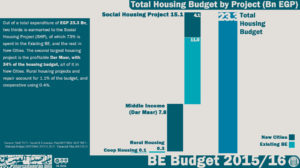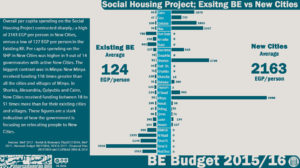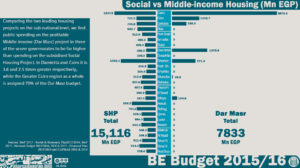- Published on 18 November 2016
*This section is part of BE Budget 2015/2016
Total Spending on Housing
A total expenditure of EGP 23.3 Bn translates to a national per capita spending of 259 EGP per person (Table 17). Over half of that is spent in New Cities, however, where per capita spending shoots up to 6249 EGP per person, dropping to 128 EGP per person in the Existing BE.
Table 17: Total and per capita spending on housing by project and administration
| Social Housing Proejct | Rural Housing (Desert Villages/ Bedouin/ Repair) | Cooperative Housing | Middle-income Housing (Dar Masr) | Total | Per Capita | |
| ‘000s EGP | ‘000s EGP | ‘000s EGP | ‘000s EGP | ‘000s EGP | EGP/ pax | |
| Existing BE | 10,971,000 | 254,500 | 103,500 | 0 | 11,329,000 | 128
|
| 72.6% | 100.0% | 100.0% | 0% | 48.6% | ||
| New Cities | 4,145,495 | 0 | 0 | 7,832,730 | 11,978,225 | 6249
|
| 27.4% | 0.0% | 0.0% | 100.0% | 51.4% | ||
| Total | 15,116,495 | 254,500 | 103,500 | 7,832,730 | 23,307,225 | 259
|
| 64.9% | 1.1% | 0.4% | 33.6% | 100.0% |
Programmatically, there are two types of government-built housing: subsidised and for profit. About two thirds of the housing budget is earmarked to subsidised housing, with the lion’s share spent on the Social Housing Project (SHP), of which 73% is spent in the Existing BE, and the rest in New Cities (fig. 13). Other subsidised housing includes Rural Housing and Repair projects (just 1.1% of the budget), and Cooperative Housing (0.4% of the budget), most of which are in the Existing BE. The profitable Dar Masr project accounted for a full 34% of the housing budget, all of which is in New Cities.

Fig. 13: Spending on housing by project and administration
Sub-national Spending on Subsidised Housing
Isolating the subsidised housing projects drops total per capita spending to 177 EGP per person (fig. 14). The highest per capita spending is in South Sinai, at 3716 EGP per person, and the Frontier governorates, which all receive much higher than average per capita amounts. The Canal governorates all received higher than average spending, with Port Said and Suez almost four and a half times the average. Greater Cairo and Alexandria, however, were around average: between 165 and 95 EGP per person. Delta governorates range between an above average 270 EGP per person in Damietta, to a two-thirds less than average 59 EGP per person in Daqahlia. The contrast was similar in Upper Egypt, with a high of 406 EGP per person in Aswan (or about three times the average) to a low of 74 EGP per person in Minya (or half the average).

Fig. 14: Local per capita spending on subsidised housing
Sub-national Spending on the Social Housing Project; New Cities versus the Existing BE
Overall per capita spending on the Social Housing Project contrasted sharply: a high of 2163 EGP per person in New Cities, versus a low of 127 EGP per person in the Existing BE (fig. 15). Per capita spending on the SHP in New Cities was higher in 9 out of 14 governorates with active New Cities. The biggest contrast was in Minya: New Minya received funding 116 times greater than all the cities and villages of Minya. In Sharkia, Alexandria, Qalyubia and Cairo, New Cities received funding between 18 to 51 times more than for their existing cities and villages. These figures are a stark indication of how the government is focusing on relocating people to New Cities.

Fig. 15: Per capita spending on the Social Housing Project; Existing BE vs New Cities
Sub-national Spending on Housing; Subsidised versus For Profit Spending
Comparing the two leading housing projects on the sub-national level, we find public spending on the profitable Dar Masr project in three of the seven governorates to be far higher than spending on Social Housing (fig. 16). In Damietta and Cairo it is 3.6 and 2.5 times greater respectively, while the Greater Cairo region as a whole is assigned 70% of the Dar Masr budget.

Fig. 16: Local spending on the Social Housing Project vs the Middle-income Housing Project
*Click here to go back to BE Budget 2015/2016
